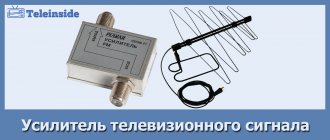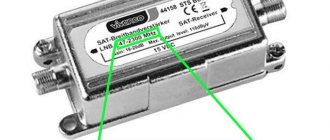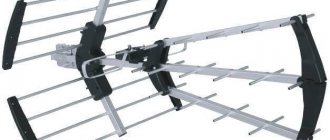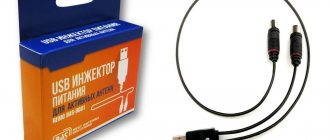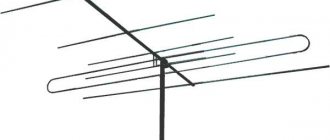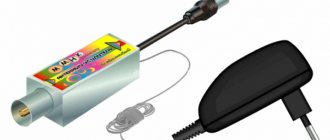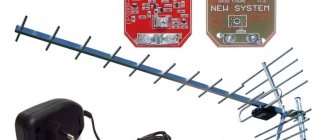Unlike terrestrial cable television, it is not received by an antenna from a television repeater, but is supplied by cable directly to the apartment. This method allows you to minimize signal loss and improve picture quality. Cable TV gives the operator the opportunity to independently regulate the number of channels, their format and encoding method. Cable TV provides subscribers with dozens and even hundreds of channels, both in analog and digital quality. Determining that you have cable TV is quite simple:
if your TV receives more than 20 channels, you are watching cable TV.
Typically, cable operators, to minimize financial losses, calculate the signal level as one TV per apartment. As a result, when wiring cables to several TVs, you have to resort to the help of an amplifier.
General information
Before installing any additional device on the TV, you need to understand the causes of the malfunctions, as well as study in detail all the ways to get out of this situation. All this information will help you choose the most effective cable TV signal amplifier and avoid any problems.
Reasons for signal deterioration
There are a large number of factors that can have a negative impact on the quality of the TV picture. Their number may vary due to the characteristics of the landscape, the quality of the equipment and the integrity of the services monitoring the repeaters.
The main reasons for the deterioration of TV picture quality:
- Transmitter maintenance. The culprit for signal deterioration is the owner of the TV. However, in some situations they become services that perform repair or maintenance work on the transmitter. The TV signal may disappear for several hours or until the problem is fixed.
- Equipment malfunction. External antennas installed on balconies or rooftops are often exposed to various natural factors. Because of this, they gradually deteriorate and inevitably fail. This problem occurs when the equipment is installed incorrectly and can lead to loss of the TV signal.
- Mistakes when choosing an antenna. All receiving devices have different characteristics and are suitable for each specific situation. If you purchase an older model or install it too low, the quality of the received signal will be significantly worse.
- High power. Sometimes the cause of a low-quality TV picture can be an excessive reception level. This problem arises due to the use of antennas with a high gain, as well as when located near a television tower.
- Cable. The cable used has a significant impact on the quality of the television signal. If you use an old one or one assembled from pieces, it may cause interference in the received signal. This applies even to those cases when the highest quality and most expensive antenna is used.
- Connectors and separators. Both of these passive design elements often reduce signal quality. This occurs due to improper installation and oxidation of connections.
- Noises. Various transmitting devices (modems, routers, telephones, radios and many others) have a strong influence on the received signal. They operate in different frequency ranges, so they often cause interference.
Advantages and disadvantages of amplifiers
A TV signal amplifier for an apartment, like any other similar device, has its advantages and disadvantages. They influence the choice of one or another equipment model and allow you to accurately determine the most effective option.
Among the positive qualities of antenna amplifiers, it is worth highlighting the following:
- Ability to receive any signals. Most models are capable of picking up even the weakest signals and amplifying them as much as possible.
- Low noise figure. All television amplifiers operate in such a way that they have virtually no negative impact on image quality and do not create additional interference.
- Ability to pick up different frequencies. Modern device models can operate in a wide frequency range of many wavelengths.
Despite these advantages, amplifiers also have several disadvantages. They must be taken into account before purchasing equipment and starting to use it. Otherwise, you may encounter various problems that will create additional difficulties and increase financial costs.
Among the disadvantages are the following:
- High degree of susceptibility to strong electrical discharges. This negative side is especially noticeable during a thunderstorm and leads to additional interference in reception.
- Self-excitation of the amplifier (the occurrence of electrical oscillations in the absence of any external influences).
- Frequent overload. It can result from exposure to powerful signals in the meter frequency range (from 49 to 230 MHz).
- Passive output losses.
What factors influence the deterioration of a TV signal?
Before studying radio engineering innovations, it is necessary to analyze why the level of functioning of the receiver is low. Causes of noise and poor image quality may include:
- significant distance of the home from the repeater;
- incorrect choice of television antenna;
- high level of natural noise;
- external obstacles to signal reception: high-rise buildings, trees, industrial buildings;
- cable failure;
- incorrect orientation of the transmitter;
- the presence of metal objects near the antenna that can conduct electricity;
- distribution of a television signal to several receivers;
- outdated technology.
Purchase and installation of the device
In order for a television amplifier to perform its functions efficiently, it is necessary to choose it correctly. It is important to consider the many factors that can degrade the signal and cause the equipment to malfunction. Only in this case can you achieve the desired result and avoid any negative consequences.
Criterias of choice
Buying a TV signal amplifier is considered a rather complicated undertaking. The TV owner needs to take into account various parameters that will help choose the optimal device model. This work can be done independently or with the help of a qualified specialist. The first option is much cheaper, but requires some experience and knowledge in this area.
You need to select a television amplifier according to the following parameters:
- Frequency range matching. The purchased device must not only be fully compatible with the TV, but also be able to work with it in the same frequency range.
- Maximum output level. Since it will be supplied to the input of a television receiver, it is best to choose those models that have a value of at least 100 dB/μV.
- Device gain. This parameter shows the maximum values by which the signal can be improved. It is recommended to purchase devices with a coefficient of at least 40 dB.
Types of devices
The purchase of one of the amplifier models depends on the type of television used. According to this criterion, all devices are divided into 3 groups and are used only in certain cases.
Types of amplifiers:
- Antenna. It is used when the receiving device is significantly removed from the repeater, as well as when there is a slight error in the selection and installation of the antenna (incorrect orientation or type). In addition, an antenna amplifier is used when signal quality deteriorates due to natural obstacles (residential buildings, industrial structures, trees). Some amplifiers are already built into the antennas and are sold together, which greatly simplifies the installation process and eliminates the need to look for a compatible device.
- Cable. This is one of the least popular devices, which is used only to enhance a low-quality signal coming from a cable television provider. Most often it is used in cases where you need to connect several TVs. All modern models of cable amplifiers are equipped with a special separator that simplifies installation work. If it is necessary to connect 3 or more television receivers, it is recommended to supplement the device with another amplifier.
- Satellite. It is used quite rarely, since it allows only a slight improvement in the quality of the received signal. Each model of such a device must correspond to the parameters of the device being received.
Installation procedure
Once all the necessary equipment has been selected, the installation process should begin. This work can be done with your own hands or with the help of a highly qualified craftsman. Self-installation is more accessible and cheaper, but always involves certain risks.
If you are not one hundred percent sure of the success of the event, then it is best to contact a specialist. In this case, costs will increase, but the quality of work will increase.
For installation you will need the following items:
- chip MAX2633;
- resistor with a resistance of at least 1 kOhm;
- a set of capacitors with a capacity of 1 nF.
It is important to prepare everything you need for work in advance so that you don’t get distracted and waste precious time during the process. The assembly of the structure should be carried out in the correct sequence. Only in this case will the device perform its functions efficiently and amplify the signal.
Full procedure:
- All required electronic components are purchased in specialized stores.
- Then preparatory activities are carried out, and the necessary tools and consumables are selected.
- After this, a dielectric plate is made, on the surface of which the electrically conductive circuits of the microcircuit used (printed circuit board) are formed.
- At the next stage, capacitors and a resistor are soldered.
- The assembled structure is checked for safety.
- An antenna and a TV are connected to the amplifier.
- The device is tested and minor defects are eliminated.
How to choose an antenna amplifier
Modern amplifiers have a lot of technical parameters listed in the documentation for the device. The trouble is that the user often does not have a sufficient level of knowledge to evaluate them correctly. Therefore, you should choose a device based on a number of the most important characteristics.
- Recommended reception range. May range from 30 to 150 km. Describes the distance between the antenna and the broadcast station at which the amplifier will produce good results.
- Frequency range. There are broadband amplifiers that work with all broadcast standards. You can buy a device only for CETV or one capable of receiving short waves well.
- Gain. It is wrong to assume that the higher this number, the better. The optimal value is at around 27 dB. This device is suitable for a reception range of up to 50 km. More serious models with a gain of about 40 dB will provide a good signal in difficult conditions. But if you put a very powerful amplifier on the antenna, it can trigger the protection of the TV or set-top box, blocking the signal.
- Supply system. Models are offered for direct connection to a 220V outlet, with a power supply or 12V, 5V input. There are products that only work with set-top boxes or TVs powered by a signal cable.
- Housing type and design. The amplifier can be designed for installation on an antenna in outdoor conditions and be protected from water and dust. Or it can be installed in an indoor case, designed to be placed only near the TV.
The optimal solution for CETV would be an amplifier powered by a signal cable. Today, a huge number of set-top boxes offer this option on the connection port.
Advice! If you are using old equipment, it is recommended to buy an amplifier with its own 5V power adapter via a signal cable.
Advice from professionals
During the assembly and installation of the signal amplifier, it is necessary to take into account not only the recommendations of the manufacturers, but also follow the advice of professionals. They will help you avoid most simple mistakes and achieve the desired result in a minimum amount of time.
Key recommendations from experts:
- The antenna amplifier must be located in close proximity to the TV. This is done in order to reduce cable losses, which can cause deterioration in the quality of the television picture.
- It is not recommended to equip indoor antennas with signal amplifiers, as this will not provide any benefits and will not eliminate interference.
- Before using the device, be sure to study the included instructions in detail. This information will help you install the device correctly and reduce the likelihood of installation errors.
- If the installed amplifier does not solve the problem, then the cause of poor signal quality should be sought in the antenna itself, its location and correspondence to wave frequencies.
- Any installation, repair or maintenance work on the device should be carried out only after it has been disconnected from the power source. There is a high risk of electric shock.
- It is prohibited to connect the signal amplifier to antennas located on the roof of a building or in rooms not equipped with lightning protection. If you neglect this advice, you may lose not only the amplifier, but also the TV.
- Do not connect a device that has visible damage to the housing, as this will increase the risk of electric shock.
A TV signal amplifier is a useful and inexpensive device. With its help, you can eliminate various interference and significantly improve the quality of the television picture. With the right approach to choosing a device and following all the recommendations of professionals, you can achieve the desired result and reduce the likelihood of malfunctions.
Methods for amplifying TV antenna power
- Change the location of the antenna. As a rule, it is directed towards the transmission tower.
- Purchasing an antenna amplifier. They are electrical devices that connect directly to the antenna and provide an impetus to improve the received signal.
- Expand the number of antennas for a clearer image, installed at the highest place.
- Change the device to a more powerful TV antenna.
- Remove all objects and metal objects that may interfere with the reception of the TV signal.
- Check the television cable for integrity. In case of short circuits or breaks, replace it with a new one. For a high-quality signal, it is important to choose the right cable.
- Create the effect of a common-mode antenna array (CAR). It consists in the fact that identical receivers form a complex system that operates on a common matched load so that the signal phases are the same.
Knowing how to improve a television signal, you can reduce image noise on the screen to a minimum and enjoy high-quality viewing, regardless of the distance to the television center.
Antenna amplifier
DIY antenna amplifier
You can design a simple device that amplifies your TV signal for your TV with your own hands. This device has low power consumption, does not create significant interference, and has a frequency range of up to 900 MHz. A low-voltage amplifier with a power supply of 2.7-5.5 V consumes a current of 3 mA and operates very quietly.
The operating principle is as follows. Voltage is applied to input “1”, which is shown on the microcircuit. Thanks to resistor R1, a bias is created in the working area. It is connected to input "2". The input signal comes to output “6”, while the amplified one is removed from node “3” and sent to the receiver. If the chip is assembled correctly, there is no need to configure it. By the way, you can also make an antenna for a TV yourself.
Various factors can negatively affect the TV signal level. Modern radio technology devices help to increase it. They have a number of advantages: mobility, high gain and a large selection of models. Thanks to the joint work of the antenna and amplifier, you can watch television in good quality.
"Folk" methods of signal improvement
In general, you can boost the signal of TV antennas with your own hands, without purchasing an amplifier. There are several ways to deal with this:
- Change the direction of the antenna. Perhaps it is simply turned in the opposite direction, and the repeater signal does not reach completely. Move it 1-2 degrees until the quality improves. You will have to act “at random,” but often the problem lies precisely in the location of the receiver.
- Increase the number of antennas. Also an effective method, although it will cost more than buying an amplifier. It is necessary to place several antennas at the same height, pointing at one point. In this case, the signal may improve, although not much.
- Buying a more powerful antenna. Also a good option, especially if you live far from the repeater.
- Shield the antenna. In this case, it is necessary to place some kind of reflector at the back (a common option is a beer can cut in half). It will reflect the waves and collect them on the “antennae”.
As you can see, you can amplify a television signal without an amplifier, although it will be either more expensive or less effective.
Review of popular models
Some amplifiers are in demand due to their simple design, low cost and easy installation. If necessary, the devices can be installed, replaced or repaired yourself.
Image gallery
Photo from
When purchasing devices for external use, take care of their tightness. It has been noted that external devices have to be replaced approximately once every 2 years, despite their protection, so if it is possible to install the amplifier under the roof, take advantage of it.
